The Empresses of Constantinople - Author: Joseph McCabe
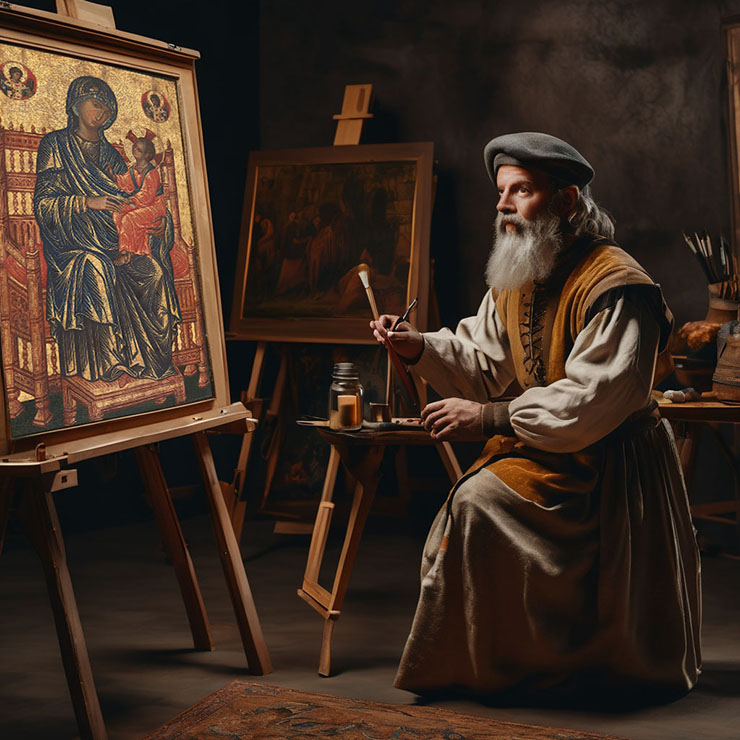 A hundred years of life still awaited the Eastern Empire from the time when John IV. returned to the throne, and half-a-dozen Empresses were yet to play their varied parts on the imperial stage. Had any impartial and sagacious observer reflected on the condition of the Empire at the time, as we have described it, he would hardly have promised it a new lease of one hundred years’ tenancy of its stricken domain. At Constantinople, of course, no one foresaw the end. It is usually in fairly robust, not in really dying, civilizations that we find an apprehension of impending ruin: as in France and England to-day. But the Byzantine Empire had shrunk to such proportions, the Turks were closing round its capital with such steady advance, and there was so little enlightenment in its mind, or real patriotism in its heart, that it seemed to be very near the end. No miracle was wrought in its favour, but it was saved for a time by one of the accidents of human history. The Tartars or Moguls attained the height of their power under the famous Timour, and the ambition of the Turk was distracted and enfeebled.
A hundred years of life still awaited the Eastern Empire from the time when John IV. returned to the throne, and half-a-dozen Empresses were yet to play their varied parts on the imperial stage. Had any impartial and sagacious observer reflected on the condition of the Empire at the time, as we have described it, he would hardly have promised it a new lease of one hundred years’ tenancy of its stricken domain. At Constantinople, of course, no one foresaw the end. It is usually in fairly robust, not in really dying, civilizations that we find an apprehension of impending ruin: as in France and England to-day. But the Byzantine Empire had shrunk to such proportions, the Turks were closing round its capital with such steady advance, and there was so little enlightenment in its mind, or real patriotism in its heart, that it seemed to be very near the end. No miracle was wrought in its favour, but it was saved for a time by one of the accidents of human history. The Tartars or Moguls attained the height of their power under the famous Timour, and the ambition of the Turk was distracted and enfeebled.
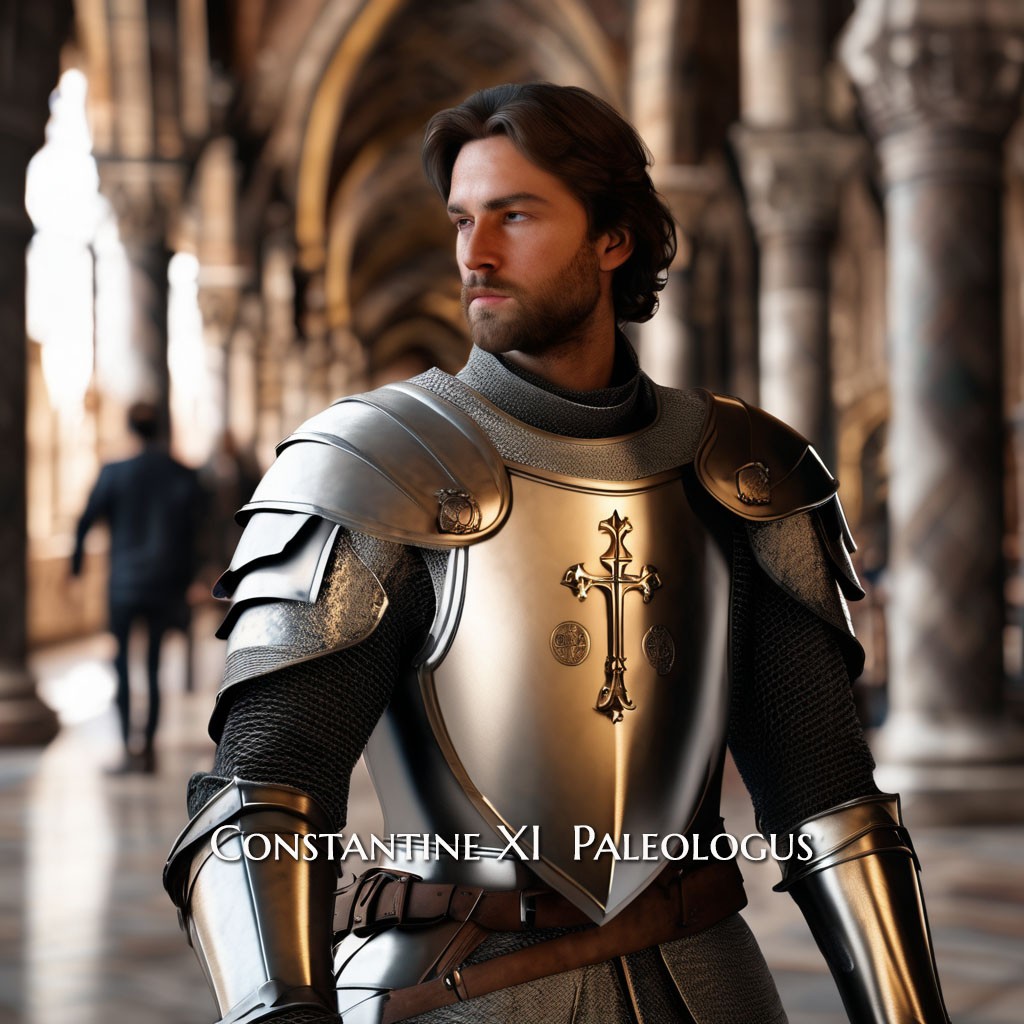 There should be a peculiar interest in studying the features of the Empresses who occupy the familiar palaces during this hundred years’ grace of the doomed civilization. We are so accustomed to finding the character of a period reflected in the character of the Empresses that the last representatives of the imperial line should afford us an instructive insight into the final life-phase of a civilization. The idea has become somewhat318 popular that nations grow old, as individuals do, and die of loss of vitality; and that in their last years they pass into singular convulsions or eccentricities. We shall, unfortunately, be impeded in this interesting study by the scantiness of the records. The ample chronicles of Cantacuzenus and his theological rival close, and two or three confused and ill-proportioned writers alone preserve for us a fragmentary record of the last hundred years. As in all such meagre records, the story of the women suffers most. Still, enough is said to give us an adequate idea of the remaining Empresses and their times; and it may be said in a word that we find no convulsions, or eccentricities, or increasing debility of individuals, but the familiar and unfortunate Byzantine character pursuing its selfish ambitions and passions until the great broom of the Turk sweeps the degenerate successors of the Romans for ever out of the East.
There should be a peculiar interest in studying the features of the Empresses who occupy the familiar palaces during this hundred years’ grace of the doomed civilization. We are so accustomed to finding the character of a period reflected in the character of the Empresses that the last representatives of the imperial line should afford us an instructive insight into the final life-phase of a civilization. The idea has become somewhat318 popular that nations grow old, as individuals do, and die of loss of vitality; and that in their last years they pass into singular convulsions or eccentricities. We shall, unfortunately, be impeded in this interesting study by the scantiness of the records. The ample chronicles of Cantacuzenus and his theological rival close, and two or three confused and ill-proportioned writers alone preserve for us a fragmentary record of the last hundred years. As in all such meagre records, the story of the women suffers most. Still, enough is said to give us an adequate idea of the remaining Empresses and their times; and it may be said in a word that we find no convulsions, or eccentricities, or increasing debility of individuals, but the familiar and unfortunate Byzantine character pursuing its selfish ambitions and passions until the great broom of the Turk sweeps the degenerate successors of the Romans for ever out of the East.
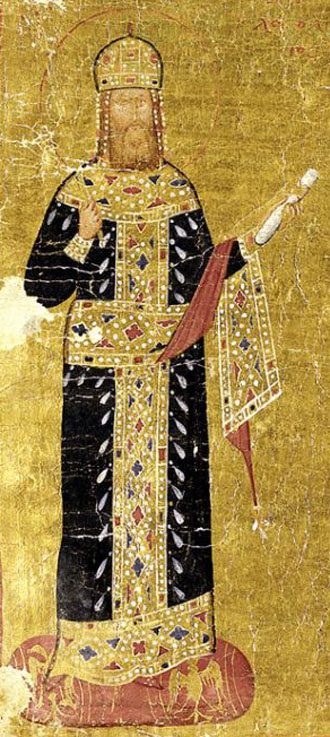 John IV., now a young man of twenty-five, occupies the throne for nearly forty years out of the remaining century, but this reign is almost barren of interest for us, and must be treated only as an introduction of his children. Helena had brought with her from Tenedos a young boy named Andronicus, and two brothers, Manuel and Theodore, were added in the course of time to the family. That is all that we find recorded of the Empress Helena. She may have died early in her husband’s reign, though the fact that he does not marry again until old age, suggests, in the case of such a man, that she lived to witness his amours and his political ineptitude. The interest passes to her children.
John IV., now a young man of twenty-five, occupies the throne for nearly forty years out of the remaining century, but this reign is almost barren of interest for us, and must be treated only as an introduction of his children. Helena had brought with her from Tenedos a young boy named Andronicus, and two brothers, Manuel and Theodore, were added in the course of time to the family. That is all that we find recorded of the Empress Helena. She may have died early in her husband’s reign, though the fact that he does not marry again until old age, suggests, in the case of such a man, that she lived to witness his amours and his political ineptitude. The interest passes to her children.
Andronicus, a pretty and spoiled boy, was betrothed in his tenth year to Maria, daughter of Alexander of Trebizond, who was about the same age when she became the Empress-elect. However, the character of Andronicus was to defraud her of the promise of the crown. We do not know in what year they were married, but it must have been before 1369, when John went to Italy, leaving Constantinople in charge of Andronicus. The Turks were again advancing, and John could see no escape except with the assistance of the Latins. He first visited Venice, and received a most flattering welcome, but no material help. Borrowing a sum of money from Venetian bankers, he went on to Rome and opened negotiations with the Vatican. It seemed to the Vatican an excellent opportunity to convince the Greeks that the Holy Ghost did proceed from both the Father and the Son—the chief dogmatical point at issue between the two Churches—and John hurriedly embraced that dogma, and would have embraced any number of dogmas, in the hope of being rewarded with an army. The reward was very meagre, however, and, after trying a few more princes with no more success, he returned to Venice to re-embark for the East. Then the Venetian moneylenders detained his imperial person as a common debtor, and he appealed to Andronicus to seize sufficient Church treasure to pay the debt.
Andronicus was enjoying his short spell of power over the shrunken treasury during his father’s absence, and the demand was irksome. He sent word to Venice that the clergy declined to allow him to seize their chalices and reliquaries, and that, to his regret, he saw no way of delivering his father from the debtors’ prison. He was a true Paleologus: a selfish voluptuary, eager only to have the sole right to the keys of the treasury. His younger brother Manuel, however, professed indignation, zealously gathered funds to meet the debt, and hastened to Venice to release his father. He may have been prompted by a sincere piety; but the natural effect of his action was that, when John returned dolefully to the city, Manuel began to wear purple boots, and the chances of Andronicus and Maria occupying the throne became slender. It appeared that, the less the Empire became, the fiercer was the struggle for it. The Turks had already reached and taken Adrianople, and Thessalonica was now the only large town in the possession of the Empire besides the capital. A few years later Thessalonica went. Manuel, who governed it, and was a youth of spirit and ambition, made a futile effort to break loose of the Turks. He was pardoned by the Sultan Murad, but he lost Thessalonica.
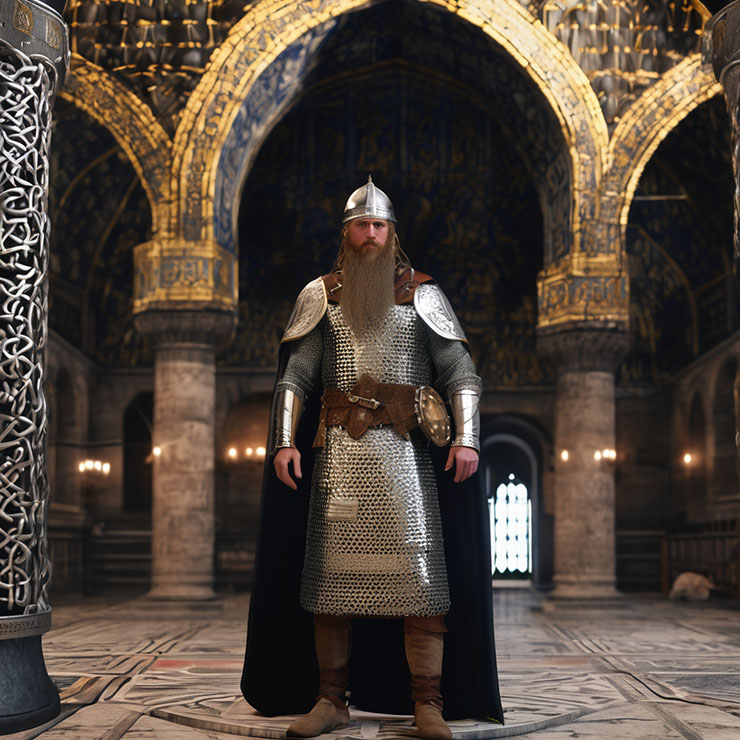 After the return of John the pressure of the Turks had been evaded by a voluntary subjection, and the Emperor of Constantinople was now a vassal of the Sultan, holding, under his sovereign lord the Turk, the city itself and a few thousand square miles of poverty-stricken territory to the west of the capital. He was compelled to do homage, and to supply a hundred soldiers, captained by one of his sons, whenever the Sultan pleased. There was, however, still a fair revenue from such sources as trade and port duties, and John contrived to excite the envy of his elder son by the luxurious dinners, the choice wines and the pretty dancing-girls, which he could still afford to enjoy. It is enough to say that John IV., in his desolate little Empire, contracted a very severe gout, and Andronicus was not unwilling to run the same risk.
After the return of John the pressure of the Turks had been evaded by a voluntary subjection, and the Emperor of Constantinople was now a vassal of the Sultan, holding, under his sovereign lord the Turk, the city itself and a few thousand square miles of poverty-stricken territory to the west of the capital. He was compelled to do homage, and to supply a hundred soldiers, captained by one of his sons, whenever the Sultan pleased. There was, however, still a fair revenue from such sources as trade and port duties, and John contrived to excite the envy of his elder son by the luxurious dinners, the choice wines and the pretty dancing-girls, which he could still afford to enjoy. It is enough to say that John IV., in his desolate little Empire, contracted a very severe gout, and Andronicus was not unwilling to run the same risk.
When, therefore, John was summoned to join the Sultan’s army in Asia, and Andronicus was once more left in charge, the foolish and egoistical youth made another effort to secure his father’s income. Sultan Murad had left his son Saudgi in charge of his European possessions, and the two princes became close friends. In 1376 the news reached the Sultan that they had disowned their fathers and proclaimed themselves independent sovereigns. The unhappy John was at once suspected of collusion, though the Sultan came in time to realize that John was not at all willing to leave the palace to his son until he was compelled to do so. The conspiracy was soon settled. As the Sultan’s troops approached, the two youths threw themselves in Didymoteichus, but they were compelled to surrender. Murad put out the eyes of Saudgi, and sent Andronicus to his father with orders to inflict the same punishment on him, under pain of war. John directed that his sight should be destroyed by boiling vinegar, and Andronicus was confined in a tower near the Blachernæ palace. His son,321 a boy of tender years, was punished in the same way, and Maria sadly joined them in the dreary tower.
 For two years Andronicus and Maria lamented their evil fortune in the tower of Anemas. In the course of time it had appeared that the blinding was not complete; Andronicus recovered the use of one eye, and his son was merely afflicted with a squint. The Sultan Murad, moreover, died, and Constantinople was not at all extravagantly devoted to the ruling monarch. Andronicus therefore found a means of communicating with the Genoese at Galata, and, with their aid, the family were stealthily delivered from the tower and taken across the water. During his brief rebellion Andronicus had promised the island of Tenedos to the Genoese in return for their help, and they had, of course, no hope of getting it from John. From Galata Andronicus made his way to the camp of the new Sultan, and promised him several hundred pounds of gold a year if he would lend him an army with which to attack his father. The Turk had, as we may see presently, a large and expensive establishment to maintain, and he accepted the bargain. Of moral or decent feeling there seemed to be a complete absence at the time in all parties. The troops were put under the command of the one-eyed fugitive, and he drew cautiously near the city.
For two years Andronicus and Maria lamented their evil fortune in the tower of Anemas. In the course of time it had appeared that the blinding was not complete; Andronicus recovered the use of one eye, and his son was merely afflicted with a squint. The Sultan Murad, moreover, died, and Constantinople was not at all extravagantly devoted to the ruling monarch. Andronicus therefore found a means of communicating with the Genoese at Galata, and, with their aid, the family were stealthily delivered from the tower and taken across the water. During his brief rebellion Andronicus had promised the island of Tenedos to the Genoese in return for their help, and they had, of course, no hope of getting it from John. From Galata Andronicus made his way to the camp of the new Sultan, and promised him several hundred pounds of gold a year if he would lend him an army with which to attack his father. The Turk had, as we may see presently, a large and expensive establishment to maintain, and he accepted the bargain. Of moral or decent feeling there seemed to be a complete absence at the time in all parties. The troops were put under the command of the one-eyed fugitive, and he drew cautiously near the city.
He had the good fortune to find John and Manuel, quite unsuspicious of his approach, in a suburban palace, and the two, together with the younger brother Theodore, were promptly lodged in the tower of Anemas, from which Andronicus had escaped. The more thoroughgoing Sultan urged Andronicus to put them to death, but such conduct did not become a Christian monarch. They were entrusted to the care of a corps of Bulgarian guards, and Andronicus and Maria mounted the gilded thrones. But their tenure did not last more than two or three years, and we may close the series of petty revolutions in a few words.
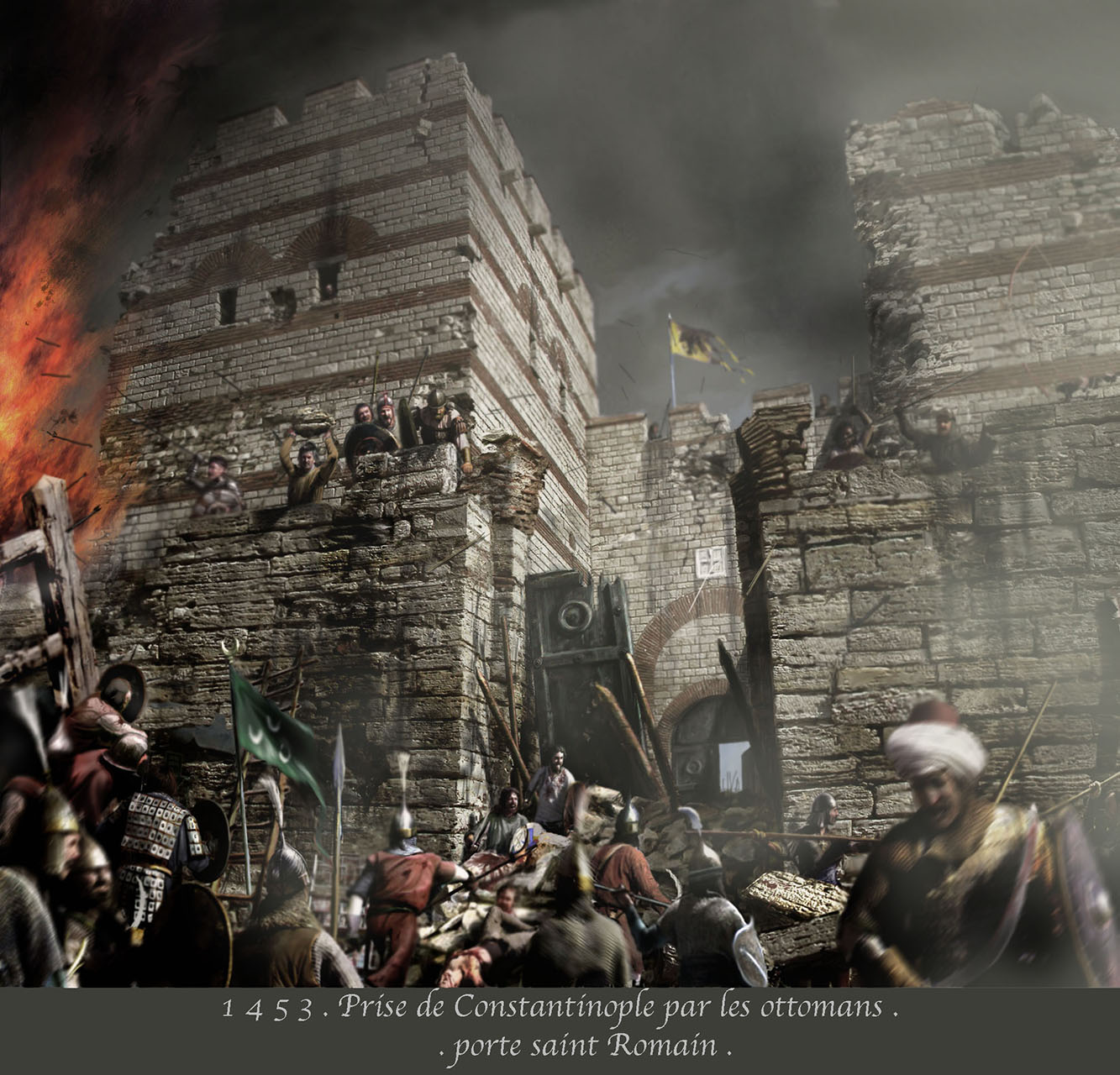 John and Manuel communicated with the Venetians and offered them the island of Tenedos—one of the few fragments of Empire that a Byzantine ruler might still sell for a tawdry crown—if they would displace Andronicus. The plot was detected in time, and the Venetians were repulsed; though they consoled themselves with taking Tenedos. In the third year of imprisonment, however, the Bulgarian guards were duped by a half-witted servant named Angel, and nicknamed Devil or Devilangel, and John and his sons escaped to Scutari and opened in their turn a deal with the Sultan. They offered him twice the sum offered by Andronicus. He genially sent an officer to learn which monarch the people really did prefer, and would defend, and was informed that Manuel was the favourite. Lest one should be disposed to think Manuel much better than the rest of the family, I may emphasize that Manuel had offered a vast sum of money out of the poor revenue of the city, and had promised to lead out two thousand troops every spring in the service of the Turk, if the crown were conferred on him. It was a sordid squabble for the last coppers of the beggared city, and it ended in a compromise. John was to occupy the throne; Andronicus and his son to be his heirs. A more or less royal residence was found for Andronicus and Maria at Selymbria, and on the revenues of that and a few other towns they contrived to maintain a tolerable state.
John and Manuel communicated with the Venetians and offered them the island of Tenedos—one of the few fragments of Empire that a Byzantine ruler might still sell for a tawdry crown—if they would displace Andronicus. The plot was detected in time, and the Venetians were repulsed; though they consoled themselves with taking Tenedos. In the third year of imprisonment, however, the Bulgarian guards were duped by a half-witted servant named Angel, and nicknamed Devil or Devilangel, and John and his sons escaped to Scutari and opened in their turn a deal with the Sultan. They offered him twice the sum offered by Andronicus. He genially sent an officer to learn which monarch the people really did prefer, and would defend, and was informed that Manuel was the favourite. Lest one should be disposed to think Manuel much better than the rest of the family, I may emphasize that Manuel had offered a vast sum of money out of the poor revenue of the city, and had promised to lead out two thousand troops every spring in the service of the Turk, if the crown were conferred on him. It was a sordid squabble for the last coppers of the beggared city, and it ended in a compromise. John was to occupy the throne; Andronicus and his son to be his heirs. A more or less royal residence was found for Andronicus and Maria at Selymbria, and on the revenues of that and a few other towns they contrived to maintain a tolerable state.
As soon as Andronicus had gone John crowned Manuel, in defiance of the treaty, and sought a fitting wife for him; and his search had the effect of bringing one more pathetic young Empress upon the scene. John was now in his sixth decade of life, a prematurely aged and very gouty man, hardly able to stand erect, but his sensuous nature was not extinct. He sent to Trebizond to ask Manuel for the daughter of the Emperor Alexis, and Eudocia Comnena, the young widow of a Turkish noble, proved to be so beautiful that the veteran libertine decided to marry her himself. He was not an old man; Du Cange puts the marriage, with some reason, about the323 year 1380, when John would be fifty-one years old. But he is described by the indignant chronicler as worn with debauch and tottering with gout, and we must think lightly of the lady who could accept his hand in order to share his crown—the crown of imitation diamonds. We have, however, no direct knowledge of Eudocia. She shared John’s imperial poverty for ten years, and disappeared at his death. We are disposed to suspect her influence when we find John, in his old age, beginning to restore the fortifications of the city in order to prepare for the last conflict with the Turk. Sultan Bayezid suddenly called on Manuel to appear at his Court, and then ordered John to destroy the two marble towers he had built beside the Golden Gate, or he would put out the eyes of Manuel. The old Emperor obeyed, and wearily lay down to die (1391).
Andronicus had died before his father, and, by the treaty of 1381, the crown should pass to his son John. But Manuel had been crowned in 1384, and he determined to seize the purple. He was still in the Court of Bayezid when the news of his father’s death came. The Turkish monarchs now had their capital at Brusa (originally Prusa), a town about sixty miles from Constantinople across the Sea of Marmora, which had been famed for some centuries as a pleasure and health resort on account of its warm springs. Here the later sultans had gathered all the luxury which would in an earlier age have passed to Constantinople. No imitation stones flashed from the turban or the scimitar of the Sultan and his nobles, for he had great stores of emeralds, rubies and diamonds; a large park sheltered curious beasts and birds from all parts of the known world; and the quiet gardens and gorgeous halls were enlivened by the forced song of the most beautiful boys and women that Greece, Servia, Bulgaria, Hungary, and even more distant Christian countries could supply. On this sybaritic paradise the dreaded Timour was to fall in a few years, but in 1391 the Tartars still lingered in the wilds, and324 the Turk dreamed of world-dominion. Manuel was one mean vassal among a crowd, the captain of a hundred feudal soldiers, in this glittering Court, and he decided to fly to Constantinople and shut himself behind its still formidable walls. They proved worthy of his trust, and for several years, though to the great suffering of the inhabitants, Manuel defied the Sultan.
During the siege, apparently, Manuel married, so that an Empress shared the straits of the long and terrible siege. She was Irene (or Helene), the daughter of Constantine Dragases, who governed a part of Macedonia. Irene is rarely mentioned in the scrappy and contradictory chronicles of the time, but she is one of the few of whom we have a pictorial representation. The miniature—found in a manuscript of the works of Denis, the so-called Areopagite—is a very quaint, though not very instructive, picture of Irene and Manuel and their two sons, but he would be a bold physiognomist who would venture to make a text of the flat and conventional features of a Byzantine portrait. Her experience of Byzantine life was dreary. During nearly seven or eight years (including the brief respite) the Turks swarmed round the walls of Constantinople, and were only prevented by their lack of powerful rams and slings—to say nothing of that new implement called a cannon, which was just entering European warfare—from penetrating. The great areas of desolation within the walls became more desolate, and the scanty supplies of food sold at appalling prices. With the Sultan outside could be seen John, the son of Andronicus, whom Bayezid affected to consider the lawful Emperor, and, although Manuel was a brave and humane ruler, the weary citizens were ready to acclaim John. But Manuel received the aid of Marshal de Boucicault and two thousand men, as well as a fleet of Venetians and Genoese, and held out stoutly until, at the close of 1399, the appearance of Timour the Tartar in the rear of the Sultan persuaded him to make peace. John was admitted as co-Emperor,325 and an effort was made to restore the stricken city.35
Manuel was the finest of the later Paleologi, and, although we cannot admire many of the steps he took to attain power, he made an excellent effort to use it for the restoration of the Empire. It seemed to him that his hope lay in enlisting the interest of the West against the infidel, and he set out at once with Irene and her two children. He left Irene in Greece, however, with his brother Theodore and Bartholomæa, and thus no Byzantine Empress was ever seen farther west than Greece. Manuel took ship to Italy, where very little was to be obtained, went to Paris, where he found Charles VI. insane, and even crossed the sea to the little island which had once sent so many Varangians to Constantinople. This visit to England induces one of the later Byzantine chroniclers (Chalcocondylas) to tell his readers something of that country, and we are interested to learn that, in the days of Henry IV., Englishmen shared their wives in common when they travelled, and held it their first duty to offer their wives to visitors; but he adds that London is already the greatest city of the West, though the strange island produces no wine and its inhabitants speak a most peculiar language.
Manuel obtained little money and few volunteers, and was returning in dejection when he heard that Timour had routed the Turks. Only a few years before Bayezid had received legates from Timour in his palace at Brusa. He had disdainfully shaved them and sent them back to their barbaric master. Then the Tartars had swept over Asia Minor, scattered all the pretty boys and ladies of the Brusa pleasance, and compelled John of Constantinople to transfer his alliance from Bayezid to himself. Manuel confirmed the vassalage on his return, but he sent John into exile and set about restoring his Empire while the giants wore down each other’s strength. But I pass over the next decade, during which the internal troubles of the Turks gave Manuel an opportunity to reform and reconstruct. Our historian, Finlay, speaks somewhat contemptuously of his work, and, able and well-intentioned as Manuel was, it may be admitted that the work was too vast for him. In any case we lose sight of Irene for several decades, after the return of Manuel in 1405, and will pass at once to the next and, as far as we know, last Empress of Constantinople.
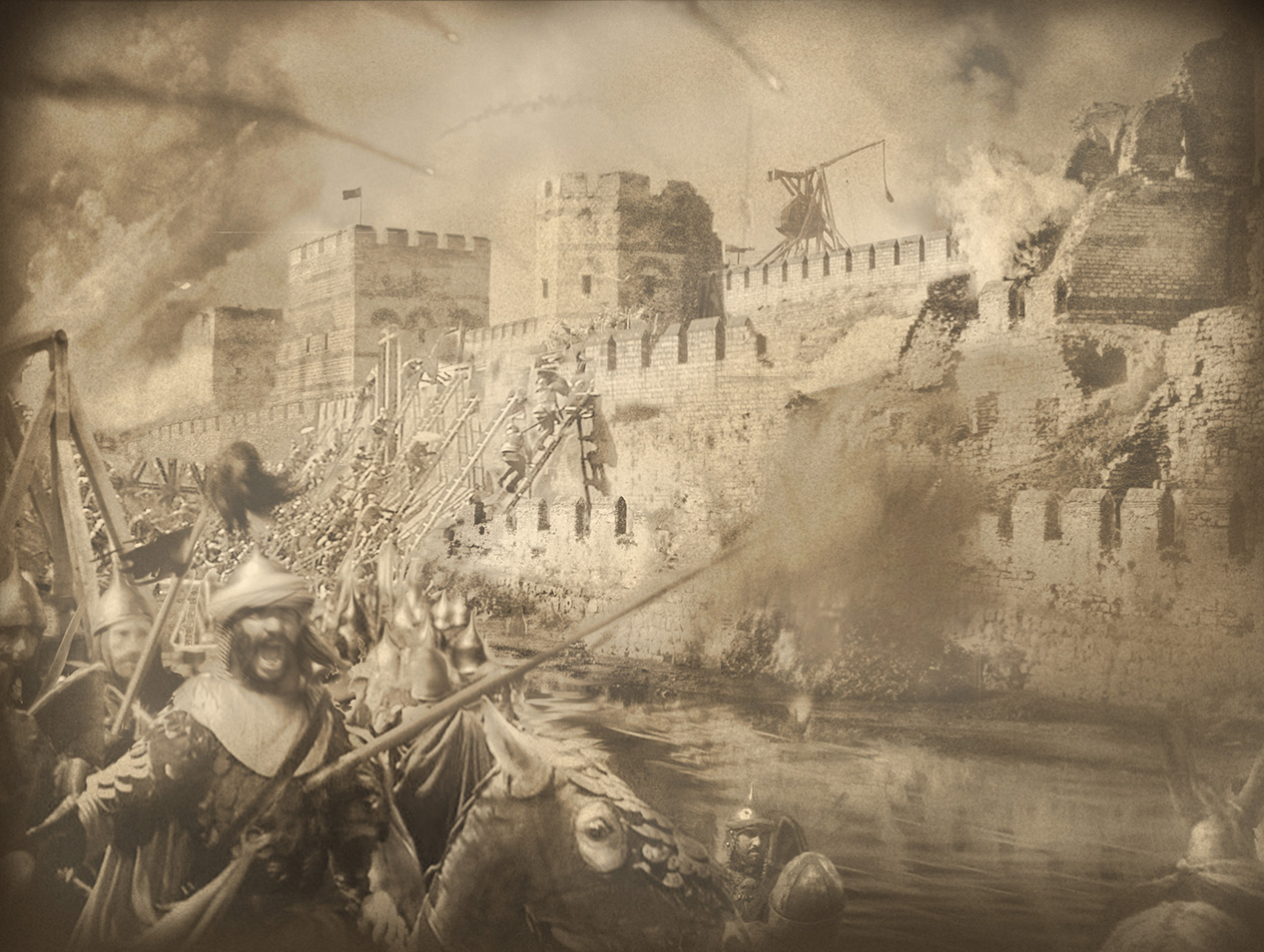 The introduction of Maria of Trebizond is preceded by some romantic adventures in the private life of the Court, of which the chroniclers give us a fairly ample account. Irene had six sons, of whom the eldest, John, married the daughter of the Grand Duke of Moscow in the year 1414. He was already twenty-four years old, and of irregular life, but the hands of the princesses and princes of Byzantium were no longer sought in the Courts of the world. Anna was a child of eleven years, and we may assume that John remained with his mistresses until, three years later, Anna was carried off by the plague. Again there seems to have been some difficulty in finding a wife for the heir to the throne, but in or about the year 1420 legates were sent to Italy, and they returned with two eligible young ladies. Cleope, the beautiful and gifted daughter of Count Malatesta of Rimini, was married to Irene’s second son, Theodore, and went to spend an unhappy life with that restless prince in Lacedæmonia. For John the legates had brought Sophia, daughter of the Marquis of Montferrat, and she and her husband at once received the imperial title.
The introduction of Maria of Trebizond is preceded by some romantic adventures in the private life of the Court, of which the chroniclers give us a fairly ample account. Irene had six sons, of whom the eldest, John, married the daughter of the Grand Duke of Moscow in the year 1414. He was already twenty-four years old, and of irregular life, but the hands of the princesses and princes of Byzantium were no longer sought in the Courts of the world. Anna was a child of eleven years, and we may assume that John remained with his mistresses until, three years later, Anna was carried off by the plague. Again there seems to have been some difficulty in finding a wife for the heir to the throne, but in or about the year 1420 legates were sent to Italy, and they returned with two eligible young ladies. Cleope, the beautiful and gifted daughter of Count Malatesta of Rimini, was married to Irene’s second son, Theodore, and went to spend an unhappy life with that restless prince in Lacedæmonia. For John the legates had brought Sophia, daughter of the Marquis of Montferrat, and she and her husband at once received the imperial title.
The appearance of Sophia of Montferrat on the imperial stage was brief and eventful. She was a tall and very graceful young woman, with golden hair that fell to her feet, a beautiful neck and broad round shoulders, fine arms, and hands and fingers “like crystal,” says327 the chronicler. But nature had spoiled these many perfections by misshaping her nose and giving a very careless finish to her eyes and eyebrows. John disliked her, kept himself coldly aloof from her, and pressed his father to send her back to Montferrat. A more chatty chronicler, however, gives a more serious reason for John’s dislike. Sophia had been as virtuous as she was beautiful until she came to Constantinople, but, whether it was the taint in the atmosphere of the Court (most of the Paleologi have natural children) or the example of her husband, she quickly lapsed. There was a natural son of her husband about the Court, and this youth she incited into a most unnatural relation. A maid of the Court caught them in flagrante delicto and told her lover; and the lover informed John. By making a hole in the wall of the bedroom John convinced himself of the truth of the story and was very indignant. It may be stated on behalf of Sophia that, when John spoke of the indignity to one of the Court jesters, he was reminded that he had himself some time before stolen his son’s mistress; it is therefore not impossible that the seduction was on the side of the youth and had a vindictive character.
Such was the kind of life witnessed in the last ruins of the Eastern Empire. John insisted that Sophia must go home; Manuel, possibly conscious of the difficulty of finding alliances, was reluctant to send her. Sophia found her position intolerable, however, and decided to run away, with the aid of the Genoese of Galata. They moored a galley at the foot of the imperial gardens, and Sophia, pretending to go for a stroll in the garden with her Italian maids and young courtiers, walked to the quay and was shipped over the water to Pera before her flight became known. It was published in the city the next day, and there was much buckling of arms and preparing of boats to avenge this last outrage of the hated Genoese. Manuel was, however, now overshadowed by his son, and Sophia was permitted to depart quietly for her home. The chronicler adds that she was received with great328 honour and rejoicing at Montferrat, and ended her days in a nunnery.
The date of Sophia’s flight and of John’s third marriage is difficult to determine. The plainest reading of the contradictory chronicles is that the trouble occurred in the last year of Manuel’s reign and the flight took place a month after his death, but this is inconsistent with the express declaration that the old Emperor intervened in the dispute. Manuel died on 25th July 1425. For some years the ambition of the Turk, who had quickly recovered from the heavy blows dealt by Timour, had fully revived and had given him great anxiety. A young Sultan, Murad II., had succeeded to the throne, and Manuel had imprudently recognized a pretender to the succession. When the young Sultan vigorously took the field, hanged the pretender, and drew up under the walls of Constantinople, Manuel, now a feeble old man of seventy-five, left the direction of affairs to John, and retired to pursue that ardent study of the Scriptures which absorbed him in his later years.
John abjectly apologized, but the angry Sultan ranged his machines against the walls and proceeded to batter them. He was drawn off for a time by the strategy of John, who had the Sultan’s brother conveyed to Brusa and set up as Sultan, but Murad returned more angry than ever, and one of the last earthly sounds to catch the ear of the aged Manuel was the roar of the first cannons that seem to have appeared at Constantinople. The diffusion of knowledge at the time may be gathered from the fact that one of the most learned of the chroniclers, in discussing these “bombards,” observes that he does not think they are of very ancient origin. Before the end of the siege Manuel was warned by an attack of apoplexy that his death was near. He donned the black robe, became plain Brother Matthew, and died two days—not two years, as Finlay says—afterwards, at the age of seventy-seven. Irene also then retired from the world and became the nun Hypomene, whom we329 shall later find endeavouring to settle the quarrels of her selfish children. She remained “mistress” (despoine) of the Empire and watched its slow decay with concern.
John was able, after the death of his father, to obtain peace from the Sultan at the price of a heavy annual subsidy, and the Empire entered upon its last quarter of a century of melancholy decay. Long years of effort had taught the sultans that their siege engines were not powerful enough to crack the heavy shell in which earlier Emperors had enclosed the city, and they were content to hold it in vassalage and draw a large tribute from its sinking revenue. The time had gone by for the last serious effort to save the Empire. Its trade had passed to the Italians, and of the provinces from which it had so long extorted its rich supply of gold there now remained only a few towns to the west of Constantinople, a part of the Peloponnesus, and Thessalonica (which would soon be sold to Venice for fifty thousand gold coins). The metropolis, therefore, continued to shrink within its eighteen-mile enclosure, and, as a severe pestilence fell on the inhabitants for the last time in 1431, they were reduced to something like one hundred thousand, instead of the million they had once been.
It was over this dismal little Empire that the last Empress, Maria of Trebizond, was called to preside. Whether the flight of Sophia came before or after the death of Manuel, John V., who succeeded his father, soon found it necessary to seek a bride. He married, in 1427, the daughter of Alexis of Trebizond, a handsome woman of excellent character, and we are fortunate enough to have a short description, from the pen of a French knight, of Maria and her desolate surroundings. Bertrandon de la Brocquière made a pilgrimage to the Holy Land, and returned through Constantinople in the year 1432. The plague had ravaged it in the previous year, and Bertrandon sympathetically refers to the broad spaces of ruin that half filled the enclosure within the walls. He notes that the Greeks are still busy with their330 processions, religious and imperial, and that they still cherish in their churches such important relics as the pillar at which Christ was scourged, the board on which his body was laid out, the gridiron on which St Lawrence had been martyred, and the stone on which Abraham had offered food to his angel visitors. Apparently the credentials of these relics had not been imposing enough to convince Western purchasers, indulgent as they were.36
When the knight heard that the Empress was about to proceed to St Sophia, and on to the Blachernæ palace, he went to the square to see the procession. We know what the spectacle would have been at an earlier date. First would come a corps of Excubitors or Varangians, with shining axes and gold accoutrements, clearing a way through the crowd. Then a regiment of pale-faced eunuchs, their leaders dressed in white silk and glittering with jewels, would precede a large body of maids and dames, from foreign slaves to the greatest ladies of the Empire, more superbly dressed than most of the queens of Europe. And lastly would come the gold-plated, gem-encrusted litter, drawn by four white horses, possibly with one of the highest nobles in Europe at the rein of each, the Empress sitting stiffly in her gold-cloth tunic, over which spread the mantle of purple silk with deep embroidered edges, and, if it were a solemn occasion, a massive domed crown on her head, from which large diamonds and pearls fell in long chains to her shoulders. Very different was the spectacle witnessed by Bertrandon de la Brocquière. Maria’s suite consisted of two ladies, three eunuchs, and three aged ministers. With this poor escort she was to drive the several miles of road to the Blachernæ palace. She wore a high hat (probably a silk-covered mitre) with three golden plumes, and she had broad flat rings, set with a few jewels, in her ears. She was young and fair; “I should not,” says the pilgrim, “have had a fault to find with her had she not been331 painted, and assuredly she had not any need of it.” The paint seems to have been the one surviving portion of the luxurious inheritance of the Empresses of Constantinople.
Maria was a woman of tame and mediocre, if faultless, character, and, as her husband was weak and incompetent, the miserable Empire lay helplessly awaiting the end. Patriotism was an extinct virtue. “The absence of truth, honour and patriotism,” says Finlay, “among the Greek aristocracy during the last century of the Eastern Empire is almost without a parallel in history.” The Western Empire had, even in its last years, had its Symmachus, its Prætextatus and its Flavianus. Irene’s sons could do no more than quarrel for their selfish interests in the ruins. Andronicus, who had charge of Thessalonica, which was restored to the Greeks for a time, sold it to Venice, and went to enjoy his fortune in the Peloponnesus. In that last fragment of the Empire Theodore and Constantine were on the verge of civil war owing to the clash of their petty ambitions. There seemed to be no resource in the East, and John, leaving the city in charge of his wife and mother, went to make a last appeal to his fellow-Christians of the West to stem the Mohammedan tide. It was now clear that the Greek Church would, as the price of assistance, have to surrender its independence to the papacy, and John took with him the patriarch and his bishops.
It may be read in history how, at the Councils of Ferrara (1438) and Florence (1439), the Greek bishops abandoned the positions they had fiercely maintained for so many centuries against the Western Church and, with one exception, signed the Roman claims. I will add from the Byzantine writers only that, whatever arguments were discussed in open Council, and however pressing the need of the Empire, it was a secret and generous payment of gold to the Byzantine bishops which finally convinced them. They bargained, like Syrian pedlars, for their signature. It may also be read332 in history how John returned in deep dejection to his mother. Instead of the promised fleet, the Pope had given him only two galleys and three hundred men and a very moderate sum of money. His wife, Maria, had died during his absence; the Sultan was pressing for an explanation of this visit to Italy; and the people and lower clergy of Constantinople were infuriated at the surrender of their spiritual independence, and were now treacherously joined by the corrupt bishops, who had signed the decrees. John wearily sustained the attack, assuring the Sultan that he had visited Italy only in order to discuss certain details of the Christian faith, and secretly pressing the Pope and the Western monarchs to fulfil their promises.
Hypomene, now an aged and venerable lady, sadly watched the struggle of her sons, and endeavoured to curb their selfish tempers. Demetrius, her youngest son, recollected that he, unlike John, had been “born in the Porphyra,” and disputed the shaking throne of his brother. He gathered about him a ragged army of Turks and looted whatever was left of the suburbs beyond the walls, until his force melted away on account of the poverty of the plunder, and he consented to be reconciled. Theodore, the second son, complained that he had not enough income to maintain his state in the town of Selymbria, which he governed, and he demanded a share of John’s. It was refused, and he in turn was about to lead troops against the capital when John, in his fifty-eighth year, was removed by a greater power (31st October 1448) from the scene of his troubles.
No one even now suspected that the next Emperor would be the last—that in five years the crescent would glitter over the imperial palaces—and the struggle for the throne broke out afresh. Demetrius alone was in the city when John died, and he noisily renewed his claim to the purple, but his character was too well known for him to find serious adherents. His mother united with the citizens in preventing him from succeeding, and they333 sent legates to ask the Sultan to allow Constantine, the ablest of the brothers, to be crowned. He had lately been opposed to the Sultan, but permission was given, and to his “despotate” at Sparta the legates were sent with the imperial ensigns. Constantinople did not even enjoy a last coronation, as the new Emperor was crowned at Sparta (6th January 1449) and would not have the ceremony repeated. He favoured the union of the Churches. He reached Constantinople in March, and the royal brothers gathered in the presence of Hypomene and such nobles as Constantinople could still boast to swear resonant oaths of peace and loyalty.
Constantine had been twice married and widowed when, in his early forties, he ascended the throne. His first wife, Theodora, daughter of the Count of Tocco, had died in 1429; his second wife, Catharine, daughter of Notaras Paleologus, had died in 1443, two years after her marriage. There were no children of either marriage, and Constantine made it one of his first duties to provide a third wife and an heir to the throne. The historian Phrantzes was entrusted with this delicate mission, and he set out from Constantinople with an escort which, it was thought, would impress the King of Iberia and the Emperor of Trebizond, to whom he was sent. It was, as he describes it, a weird mixture of monks, musicians and medical men; their baggage consisted mainly of musical instruments, instead of the superb robes and plate that an earlier escort might have taken, and Phrantzes says that they did impress and astonish the foreign Courts. But they were unfortunately wrecked on the way to Iberia, a country between the Black Sea and the Caspian, and seem to have been detained for nearly two years by lack of funds; and they then discovered that the King of Iberia expected a gift for his daughter, instead of presenting one with her, and returned unsuccessful to Constantinople.
In the meantime—apparently on 23rd March 1450—Hypomene had brought to a close her long and troubled334 life. With her death the series of Empresses of Constantinople comes to an end, but their story cannot be intelligibly concluded without a glance at the great catastrophe which, three years later, swept away the tottering thrones and made an end of Christian Byzantium.
The Sultan Murad II., who had so long looked with indulgent eye on the remnant of the Byzantine Empire, died in 1451. His son and successor, Mohammed II., was a young man of twenty-one years: a very able, highly cultivated and extremely ambitious young prince. To him the existence of this Christian island, the city of Constantinople, in the ocean of Mohammedan conquest was an intolerable anomaly. The Turks had long since carried the crescent over what we now call Turkey in Europe, and it was only by sea that Constantinople could communicate directly with the other Christian powers. To put an end to this Christian avenue into the heart of his dominion and make the great city the capital of the Mohammedan world was the early ambition of Mohammed II. Probably every sultan for a hundred years or more had desired this, but their siege machinery had hitherto proved incapable of shattering the stout old walls of that city.
Constantine XI. underrated the young Sultan, and very soon gave him a pretext for an attack. Mohammed had signed a truce with the Hungarians, and gone to settle certain disturbances in his Asiatic dominions, when he received a most insolent and offensive message from Constantinople. He must at once increase the pension of Prince Orkhan (the nephew of Suleiman, then living in retirement at Constantinople), or else the Greeks will consider Orkhan’s claim to the Turkish throne. It was the last blunder of the Paleologi. Mohammed courteously heard and dismissed the legates, and proceeded to pacify his Asiatic province. Constantine had grossly failed to appreciate the young Sultan’s character. After his coronation at Adrianople his Christian vassals—the Emperors of Trebizond and Constantinople, the Duke of Athens, etc.—had hastened to do homage, and had seen only an accomplished, amiable and, in private life, vicious young man, from whom they had little to fear.
Shortly afterwards the Court at Constantinople was alarmed to hear that a large army of Turkish workmen had arrived at a spot on the Asiatic coast only five miles from the city, and were, with great rapidity, building a powerful fort which would command the entrance to the Black Sea. Constantine sent a protest; Mohammed disdainfully replied that he would do as he liked in his own dominions. In time the Turkish soldiers of the district fell to quarrels with Constantine’s subjects, and the Emperor, ordering the gates of the city to be closed, demanded some recompense. Mohammed at once declared war, and went to Adrianople to concentrate his forces and gather a more powerful armament than his predecessors had used. The value of powder was now realized, and, although they were crude objects of only moderate effectiveness, immense cannons, which could throw stone balls weighing more than a hundred pounds, were associated with the old rams and slings and towers.
Constantine quickly realized the gravity of his position, and made every effort to patch the fortifications, enlist troops and provision the town. An urgent appeal was sent to Italy, and hundreds of volunteers and adventurers were attracted; though the Pope was still mainly concerned about the recognition of his supremacy, and sent a cardinal who distracted the doomed city with fierce religious controversy. When the hour came, Constantine found that barely six thousand Greeks could be induced to enlist in the last defence of their city, and these, with other two or three thousand Italians, had to hold fifteen miles of wall, with many gates, against seventy thousand Turks and three hundred vessels.
On 12th December 1452 the church of St Sophia rang with its last great Christian celebration, the solemn union of the Latin and Greek Churches, the price of that secular aid which was destined never to arrive. Four months336 later the vanguard of the Turks was descried from the walls, and day by day the endless regiments and engines of attack and the monstrous cannons came from the line of the horizon and took up their stations. For a time the spirits of the besieged were maintained by those little successes which so often precede a great catastrophe. Four large Italian ships had fought their way through the Turkish fleet and brought provisions: Mohammed’s biggest gun had burst: a general attack of the enemy had been repulsed. But the incessant rain of projectiles made at last a ghastly breach in the stout wall, and on 29th May, before dawn, the dreaded Janissaries flung themselves at the defenders. The last of the Paleologi died like a man. Later in the day the victorious Turks swept over his body and the bodies of some thousands of his people, and the last remnant of the Byzantine Empire was swallowed up in the Mohammedan tide. And the relics of its culture passed westward and, meeting and blending with the humanism of the later Middle Ages, begot the new man and new woman of the Renaissance, the heralds of modern times.
337
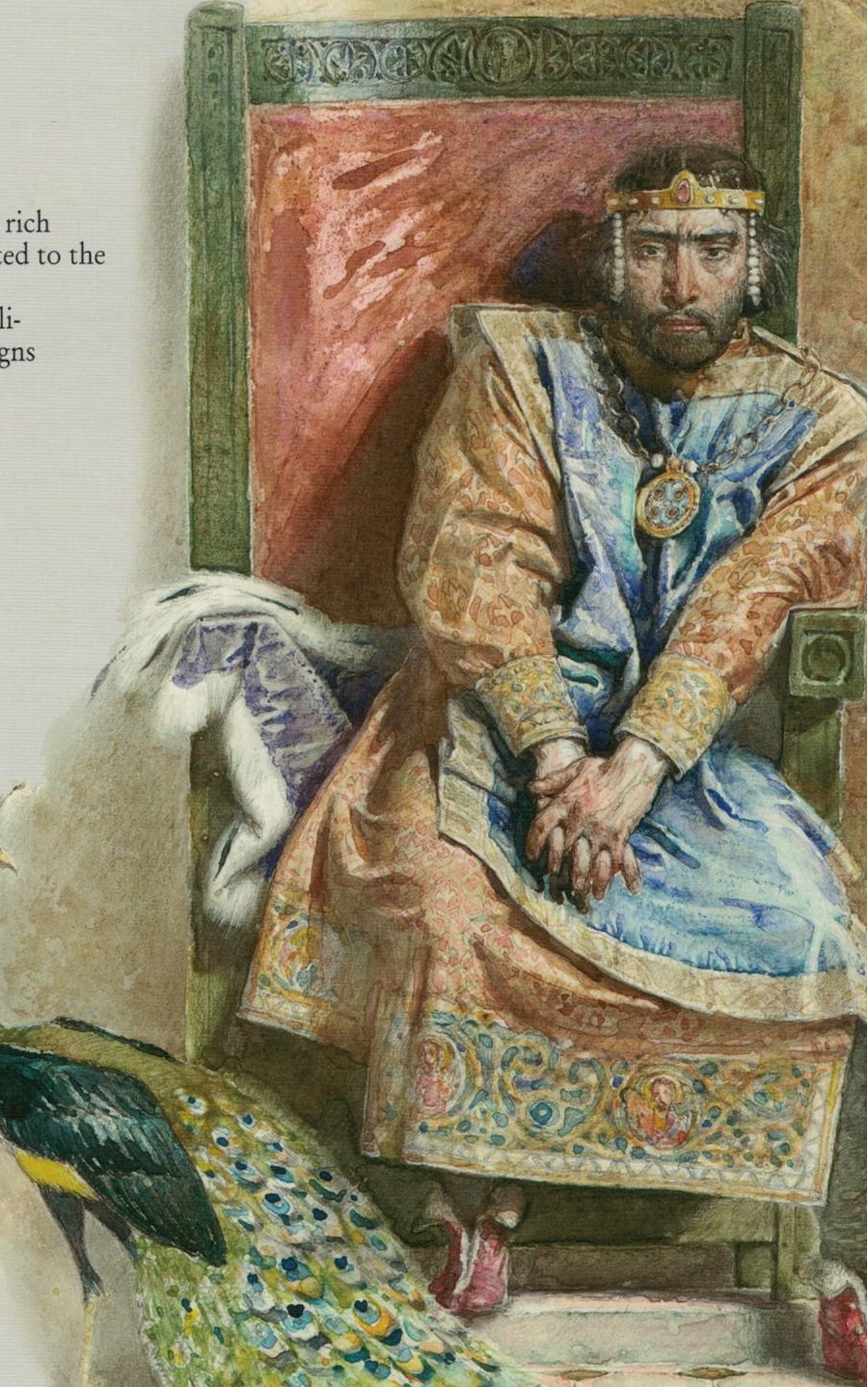 Emperor John I Tzimiskes, the murderer of his uncle Nikephorus II Phocas in his bed in the Boukoleon Palace. John married his uncle's wife, who was his co-conspirator in the assassination.
Emperor John I Tzimiskes, the murderer of his uncle Nikephorus II Phocas in his bed in the Boukoleon Palace. John married his uncle's wife, who was his co-conspirator in the assassination.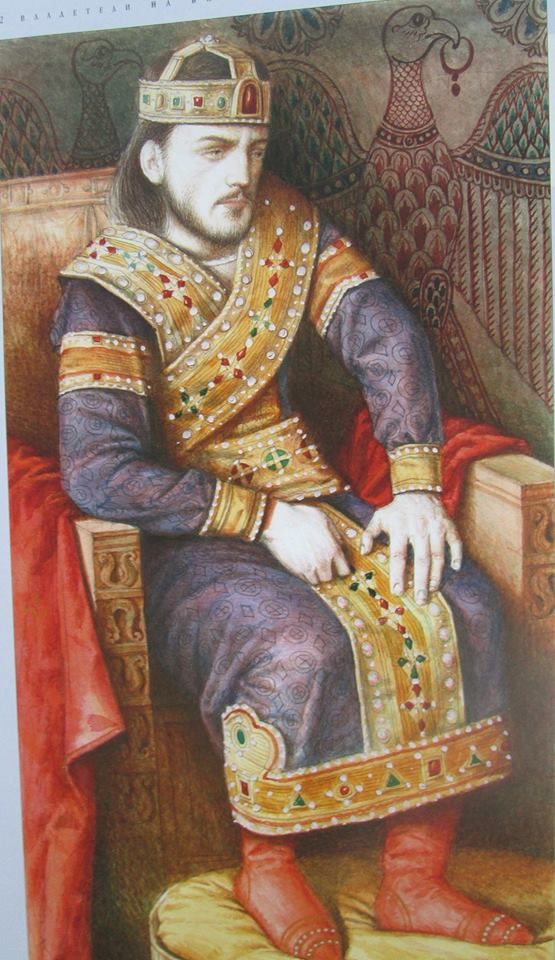
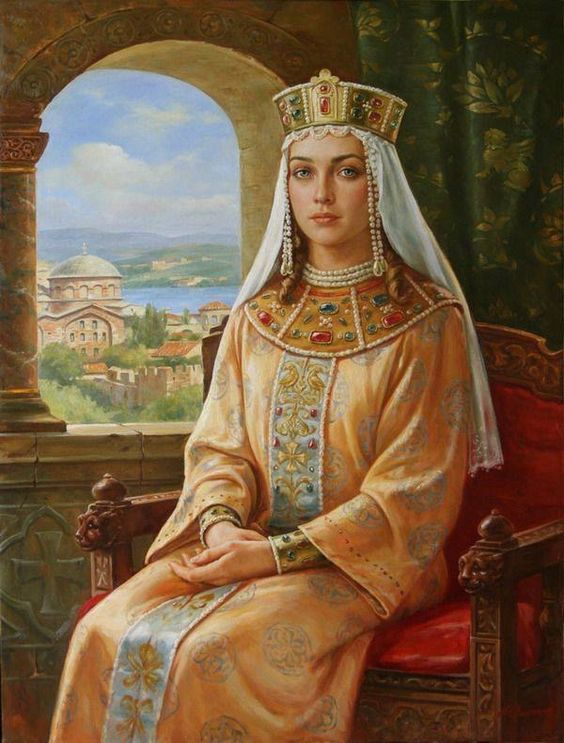
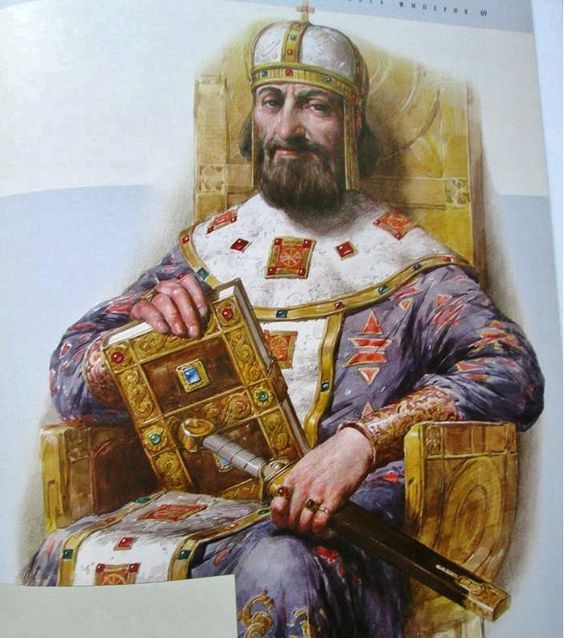
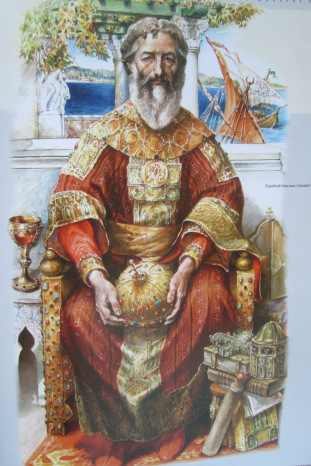
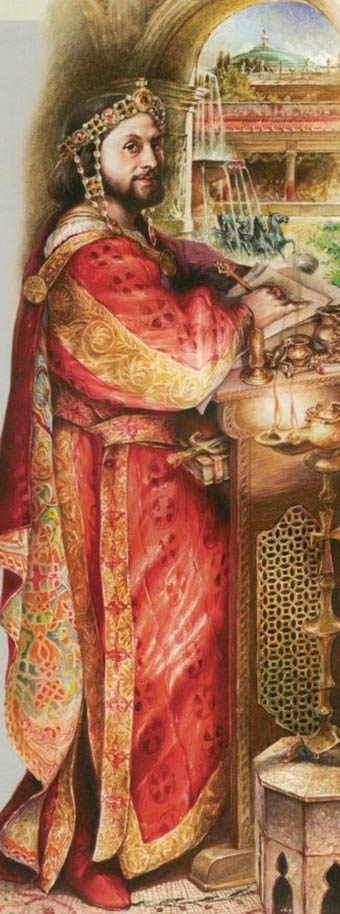

 A hundred years of life still awaited the Eastern Empire from the time when John IV. returned to the throne, and half-a-dozen Empresses were yet to play their varied parts on the imperial stage. Had any impartial and sagacious observer reflected on the condition of the Empire at the time, as we have described it, he would hardly have promised it a new lease of one hundred years’ tenancy of its stricken domain. At Constantinople, of course, no one foresaw the end. It is usually in fairly robust, not in really dying, civilizations that we find an apprehension of impending ruin: as in France and England to-day. But the Byzantine Empire had shrunk to such proportions, the Turks were closing round its capital with such steady advance, and there was so little enlightenment in its mind, or real patriotism in its heart, that it seemed to be very near the end. No miracle was wrought in its favour, but it was saved for a time by one of the accidents of human history. The Tartars or Moguls attained the height of their power under the famous Timour, and the ambition of the Turk was distracted and enfeebled.
A hundred years of life still awaited the Eastern Empire from the time when John IV. returned to the throne, and half-a-dozen Empresses were yet to play their varied parts on the imperial stage. Had any impartial and sagacious observer reflected on the condition of the Empire at the time, as we have described it, he would hardly have promised it a new lease of one hundred years’ tenancy of its stricken domain. At Constantinople, of course, no one foresaw the end. It is usually in fairly robust, not in really dying, civilizations that we find an apprehension of impending ruin: as in France and England to-day. But the Byzantine Empire had shrunk to such proportions, the Turks were closing round its capital with such steady advance, and there was so little enlightenment in its mind, or real patriotism in its heart, that it seemed to be very near the end. No miracle was wrought in its favour, but it was saved for a time by one of the accidents of human history. The Tartars or Moguls attained the height of their power under the famous Timour, and the ambition of the Turk was distracted and enfeebled. There should be a peculiar interest in studying the features of the Empresses who occupy the familiar palaces during this hundred years’ grace of the doomed civilization. We are so accustomed to finding the character of a period reflected in the character of the Empresses that the last representatives of the imperial line should afford us an instructive insight into the final life-phase of a civilization. The idea has become somewhat
There should be a peculiar interest in studying the features of the Empresses who occupy the familiar palaces during this hundred years’ grace of the doomed civilization. We are so accustomed to finding the character of a period reflected in the character of the Empresses that the last representatives of the imperial line should afford us an instructive insight into the final life-phase of a civilization. The idea has become somewhat John IV., now a young man of twenty-five, occupies the throne for nearly forty years out of the remaining century, but this reign is almost barren of interest for us, and must be treated only as an introduction of his children. Helena had brought with her from Tenedos a young boy named Andronicus, and two brothers, Manuel and Theodore, were added in the course of time to the family. That is all that we find recorded of the Empress Helena. She may have died early in her husband’s reign, though the fact that he does not marry again until old age, suggests, in the case of such a man, that she lived to witness his amours and his political ineptitude. The interest passes to her children.
John IV., now a young man of twenty-five, occupies the throne for nearly forty years out of the remaining century, but this reign is almost barren of interest for us, and must be treated only as an introduction of his children. Helena had brought with her from Tenedos a young boy named Andronicus, and two brothers, Manuel and Theodore, were added in the course of time to the family. That is all that we find recorded of the Empress Helena. She may have died early in her husband’s reign, though the fact that he does not marry again until old age, suggests, in the case of such a man, that she lived to witness his amours and his political ineptitude. The interest passes to her children. After the return of John the pressure of the Turks had been evaded by a voluntary subjection, and the Emperor of Constantinople was now a vassal of the Sultan, holding, under his sovereign lord the Turk, the city itself and a few thousand square miles of poverty-stricken territory to the west of the capital. He was compelled to do homage, and to supply a hundred soldiers, captained by one of his sons, whenever the Sultan pleased. There was, however, still a fair revenue from such sources as trade and port duties, and John contrived to excite the envy of his elder son by the luxurious dinners, the choice wines and the pretty dancing-girls, which he could still afford to enjoy. It is enough to say that John IV., in his desolate little Empire, contracted a very severe gout, and Andronicus was not unwilling to run the same risk.
After the return of John the pressure of the Turks had been evaded by a voluntary subjection, and the Emperor of Constantinople was now a vassal of the Sultan, holding, under his sovereign lord the Turk, the city itself and a few thousand square miles of poverty-stricken territory to the west of the capital. He was compelled to do homage, and to supply a hundred soldiers, captained by one of his sons, whenever the Sultan pleased. There was, however, still a fair revenue from such sources as trade and port duties, and John contrived to excite the envy of his elder son by the luxurious dinners, the choice wines and the pretty dancing-girls, which he could still afford to enjoy. It is enough to say that John IV., in his desolate little Empire, contracted a very severe gout, and Andronicus was not unwilling to run the same risk. For two years Andronicus and Maria lamented their evil fortune in the tower of Anemas. In the course of time it had appeared that the blinding was not complete; Andronicus recovered the use of one eye, and his son was merely afflicted with a squint. The Sultan Murad, moreover, died, and Constantinople was not at all extravagantly devoted to the ruling monarch. Andronicus therefore found a means of communicating with the Genoese at Galata, and, with their aid, the family were stealthily delivered from the tower and taken across the water. During his brief rebellion Andronicus had promised the island of Tenedos to the Genoese in return for their help, and they had, of course, no hope of getting it from John. From Galata Andronicus made his way to the camp of the new Sultan, and promised him several hundred pounds of gold a year if he would lend him an army with which to attack his father. The Turk had, as we may see presently, a large and expensive establishment to maintain, and he accepted the bargain. Of moral or decent feeling there seemed to be a complete absence at the time in all parties. The troops were put under the command of the one-eyed fugitive, and he drew cautiously near the city.
For two years Andronicus and Maria lamented their evil fortune in the tower of Anemas. In the course of time it had appeared that the blinding was not complete; Andronicus recovered the use of one eye, and his son was merely afflicted with a squint. The Sultan Murad, moreover, died, and Constantinople was not at all extravagantly devoted to the ruling monarch. Andronicus therefore found a means of communicating with the Genoese at Galata, and, with their aid, the family were stealthily delivered from the tower and taken across the water. During his brief rebellion Andronicus had promised the island of Tenedos to the Genoese in return for their help, and they had, of course, no hope of getting it from John. From Galata Andronicus made his way to the camp of the new Sultan, and promised him several hundred pounds of gold a year if he would lend him an army with which to attack his father. The Turk had, as we may see presently, a large and expensive establishment to maintain, and he accepted the bargain. Of moral or decent feeling there seemed to be a complete absence at the time in all parties. The troops were put under the command of the one-eyed fugitive, and he drew cautiously near the city. John and Manuel communicated with the Venetians and offered them the island of Tenedos—one of the few fragments of Empire that a Byzantine ruler might still sell for a tawdry crown—if they would displace Andronicus. The plot was detected in time, and the Venetians were repulsed; though they consoled themselves with taking Tenedos. In the third year of imprisonment, however, the Bulgarian guards were duped by a half-witted servant named Angel, and nicknamed Devil or Devilangel, and John and his sons escaped to Scutari and opened in their turn a deal with the Sultan. They offered him twice the sum offered by Andronicus. He genially sent an officer to learn which monarch the people really did prefer, and would defend, and was informed that Manuel was the favourite. Lest one should be disposed to think Manuel much better than the rest of the family, I may emphasize that Manuel had offered a vast sum of money out of the poor revenue of the city, and had promised to lead out two thousand troops every spring in the service of the Turk, if the crown were conferred on him. It was a sordid squabble for the last coppers of the beggared city, and it ended in a compromise. John was to occupy the throne; Andronicus and his son to be his heirs. A more or less royal residence was found for Andronicus and Maria at Selymbria, and on the revenues of that and a few other towns they contrived to maintain a tolerable state.
John and Manuel communicated with the Venetians and offered them the island of Tenedos—one of the few fragments of Empire that a Byzantine ruler might still sell for a tawdry crown—if they would displace Andronicus. The plot was detected in time, and the Venetians were repulsed; though they consoled themselves with taking Tenedos. In the third year of imprisonment, however, the Bulgarian guards were duped by a half-witted servant named Angel, and nicknamed Devil or Devilangel, and John and his sons escaped to Scutari and opened in their turn a deal with the Sultan. They offered him twice the sum offered by Andronicus. He genially sent an officer to learn which monarch the people really did prefer, and would defend, and was informed that Manuel was the favourite. Lest one should be disposed to think Manuel much better than the rest of the family, I may emphasize that Manuel had offered a vast sum of money out of the poor revenue of the city, and had promised to lead out two thousand troops every spring in the service of the Turk, if the crown were conferred on him. It was a sordid squabble for the last coppers of the beggared city, and it ended in a compromise. John was to occupy the throne; Andronicus and his son to be his heirs. A more or less royal residence was found for Andronicus and Maria at Selymbria, and on the revenues of that and a few other towns they contrived to maintain a tolerable state. The introduction of Maria of Trebizond is preceded by some romantic adventures in the private life of the Court, of which the chroniclers give us a fairly ample account. Irene had six sons, of whom the eldest, John, married the daughter of the Grand Duke of Moscow in the year 1414. He was already twenty-four years old, and of irregular life, but the hands of the princesses and princes of Byzantium were no longer sought in the Courts of the world. Anna was a child of eleven years, and we may assume that John remained with his mistresses until, three years later, Anna was carried off by the plague. Again there seems to have been some difficulty in finding a wife for the heir to the throne, but in or about the year 1420 legates were sent to Italy, and they returned with two eligible young ladies. Cleope, the beautiful and gifted daughter of Count Malatesta of Rimini, was married to Irene’s second son, Theodore, and went to spend an unhappy life with that restless prince in Lacedæmonia. For John the legates had brought Sophia, daughter of the Marquis of Montferrat, and she and her husband at once received the imperial title.
The introduction of Maria of Trebizond is preceded by some romantic adventures in the private life of the Court, of which the chroniclers give us a fairly ample account. Irene had six sons, of whom the eldest, John, married the daughter of the Grand Duke of Moscow in the year 1414. He was already twenty-four years old, and of irregular life, but the hands of the princesses and princes of Byzantium were no longer sought in the Courts of the world. Anna was a child of eleven years, and we may assume that John remained with his mistresses until, three years later, Anna was carried off by the plague. Again there seems to have been some difficulty in finding a wife for the heir to the throne, but in or about the year 1420 legates were sent to Italy, and they returned with two eligible young ladies. Cleope, the beautiful and gifted daughter of Count Malatesta of Rimini, was married to Irene’s second son, Theodore, and went to spend an unhappy life with that restless prince in Lacedæmonia. For John the legates had brought Sophia, daughter of the Marquis of Montferrat, and she and her husband at once received the imperial title.



 click here for icons of christ
click here for icons of christ click here for icons of the theotokos
click here for icons of the theotokos click here for icons of angels
click here for icons of angels click here for icons of saints
click here for icons of saints








